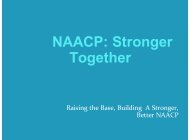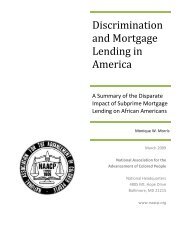TOOLKIT
TOOLKIT
TOOLKIT
Create successful ePaper yourself
Turn your PDF publications into a flip-book with our unique Google optimized e-Paper software.
Project: Be Prepared<br />
Disaster response starts on the local level, so, by getting involved,<br />
your Youth Council/College Chapter can be an asset to your<br />
community. Being prepared for such disasters on the most basic<br />
level is crucial to the survival of you and your community. The<br />
critical role of the NAACP includes acting as monitors and<br />
advocates for civil and human rights in times of disaster.<br />
Walk:<br />
Together, the Youth Council/College Chapter takes the American<br />
Red Cross Ready Rating 123 Assessment: www.readyrating.org or<br />
a class from FEMA’s Emergency Management Institute:<br />
http://training.fema.gov/IS/collegecredits.asp<br />
Host a film screening featuring films related to the importance of<br />
emergency management.<br />
See suggestions below:<br />
If God is Willing and Da Creek Don’t Rise, HBO,<br />
Spike Lee, 2010<br />
Trouble the Water, Elsewhere Films and<br />
Louverture Films LLC, Zeitgeist Films, 2008<br />
www.troublethewaterfilm.com<br />
When the Levees Broke: A Requiem in Four Parts,<br />
HBO, Spike Lee, 2006<br />
Run:<br />
Partner with a local food bank to host a canned food drive for<br />
survivors of a natural disaster, depending on your location.<br />
An example of a good cause is Hurricane Isaac relief.<br />
For every 100 cans collected, the Youth Council/College Chapter<br />
will receive an additional 50 steps.<br />
Steps to putting together a Canned Food drive:<br />
Contact Your Local Food Bank feedingamerica.org/waysto-give/food-grocery-food-drives.aspx<br />
Build a Team<br />
Set a Date<br />
Pick a Location<br />
Publicize Your Event<br />
Another resource:<br />
http://www.conagrafoods.com/pdf/Organize%20a%20Food%20Dri<br />
ve.pdf<br />
Sprint:<br />
Develop a disaster plan at the campus, branch level or state<br />
conference. http://arcbrcr.org/<br />
MILE MARKER 4:<br />
EMERGENCY PREPAREDNESS<br />
Resources<br />
FEMA: www.fema.gov:<br />
Example of a State program k-12: “NY<br />
It’s Time To Get Ready manual”<br />
www.nyc.gov/html/oem/downloads/pdf/ki<br />
ds_journal_english.pdf<br />
Citizen Corps: www.citizencorps.gov:<br />
find your state and the resources it offers<br />
to your community.<br />
For youth:<br />
www.citizencorps.gov/ready/kids.shtm<br />
American Red Cross: www.redcross.org<br />
Community Emergency Response<br />
Teams (CERT):<br />
http://www.citizencorps.gov/cert/<br />
Reporting<br />
Remember that different forms of<br />
movement are worth specific steps.<br />
Walk = 50 steps<br />
Run = 100 steps<br />
Sprint = 150 steps<br />
Hydration stations = 25 steps<br />
In order to receive credit for the 10,000<br />
steps all activities must be documented.<br />
To report projects, click on this<br />
link<br />
Fill out the form titled<br />
REPORTING.<br />
Please make sure all the text<br />
boxes are filled out completely.<br />
It is also recommended that activities are<br />
uploaded to the official NAACP pages<br />
listed below with a brief commentary<br />
which includes:<br />
Name of Youth Council/College<br />
Chapter<br />
<br />
<br />
Location<br />
2-4 sentences describing the<br />
activity.<br />
When using social media, use the<br />
hashtags: #10KSteps, #NAACPECJP or<br />
tag NAACP, NAACPConnect,<br />
NAACPECJP.<br />
40 | P a g e








